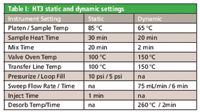Detection Limits of EPA Method 8260 with Static and Dynamic Headspace GC–MS Analysis
EPA Method 8260 provides for the analysis of volatile organic compounds (VOC) in various solid waste matrices.
EPA Method 8260 provides for the analysis of volatile organic compounds (VOC) in various solid waste matrices. The referenced EPA Method 5021, allows for the introduction of VOCs from solid samples by automated static headspace. The static headspace method permits the prescreening of samples to minimize over saturation of the chromatography system. The Teledyne Tekmar HT3 static and dynamic headspace methods were used to perform a comparison of the detection limit of an 8260 standard.
Experimental Conditions
A Teledyne Tekmar HT3™ with static and dynamic modes and a Number 9 trap was interfaced to a Varian 431GC 210 MS and FactorFourTM VF624ms, 20 m × 0.15 mm × 0.84 μm column. Standard solutions were prepared in water at concentrations from 0.5 to 200 ppb with a 25 ppb internal standard solution. 5 mL of the solutions were placed into 22 mL headspace vials and sealed. The HT3™ was prepared to inject the standards onto the GC–MS system with either a static or dynamic method. The parameters for the static and dynamic are presented in Table I (1).

Table I: HT3 static and dynamic settings
Results
The total ion chromatograms (TIC) of each standard concentration for both the static or dynamic mode was reviewed for detection of the compounds. The lowest detection limits were 0.5 ppb in the dynamic mode and 10 ppb in the static mode. The peak areas of the 10 ppb standard from the static and dynamic method were compared. Figure 1 is the comparison of the TIC of the static and dynamic methods 10 ppb standard.
The dynamic method typically produced peak areas ranging from 20 times greater for methyl tert-butyl ether to 60 times greater for 1,3-dichloropropene than the static headspace mode. The dynamic method also produced a peak area 125 times greater for dibromofluoromethane.

Figure 1: Comparison of the total ion chromatogram of a 10 ppb standard in the dynamic mode (top) and the static mode (bottom). The dynamic scale is 0 to 200 kCounts. The static scale is 0 to 8 kCounts. The mass spectrometer was scanned from 47 to 160 m/z to 2.5 min, then 35 to 280 mz causing the baseline shift in the static chromatogram. The water peak from 1 to 1.5 min in the static mode (bottom) was reduced with a dry purge time of 2 min in the dynamic mode.
Conclusion
The HT3 provided detection of Method 8260 VOC to 10 ppb in the static mode and 0.5 ppb in the dynamic mode. The dynamic mode also provided 20 to 60 times greater detection than the static mode. The HT3™ is a versatile headspace analyzer that provides excellent detection of compounds in either the static or dynamic mode for prescreening solid waste sample from ppb to ppm levels depending on method requirements.
Reference
(1) Brian Bertsch, Teledyne Tekmar Application Note, "Prevent Damage to Your Purge and Trap by Pre-Screening with Static Headspace."

Teledyne Tekmar
4736 Socialville Foster Road, Mason, OH 45040
tel. (800)874-2004; fax (513)229-7050
Website: www.teledynetekmar.com

Separation of Ultra-Short and Long Chain PFAS Compounds Using a Positive Charge Surface Column
December 11th 2024A separation of ultra-short and long chain PFAS (C1-C18) is performed on a HALO®PCS Phenyl-Hexyl column along with a HALO®PFAS Delay column which demonstrates excellent retention for both hydrophilic and hydrophobic analytes.

.png&w=3840&q=75)

.png&w=3840&q=75)



.png&w=3840&q=75)



.png&w=3840&q=75)














